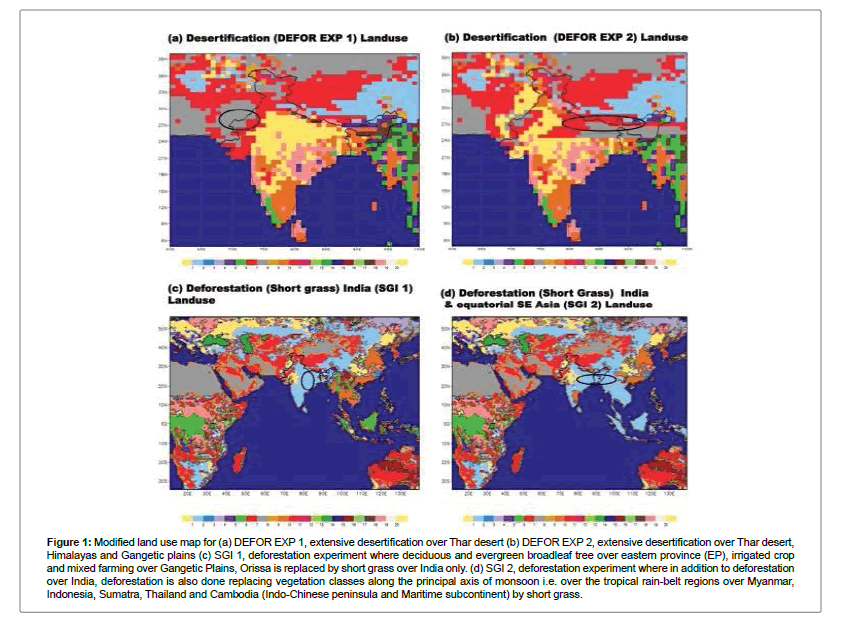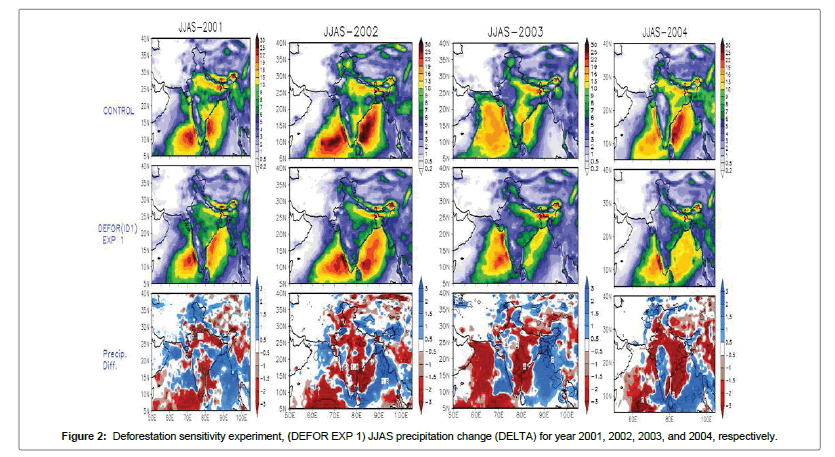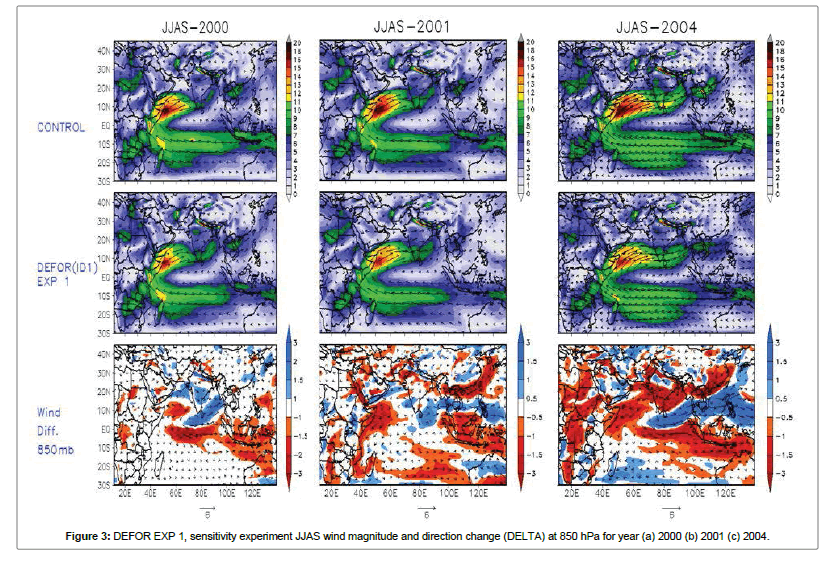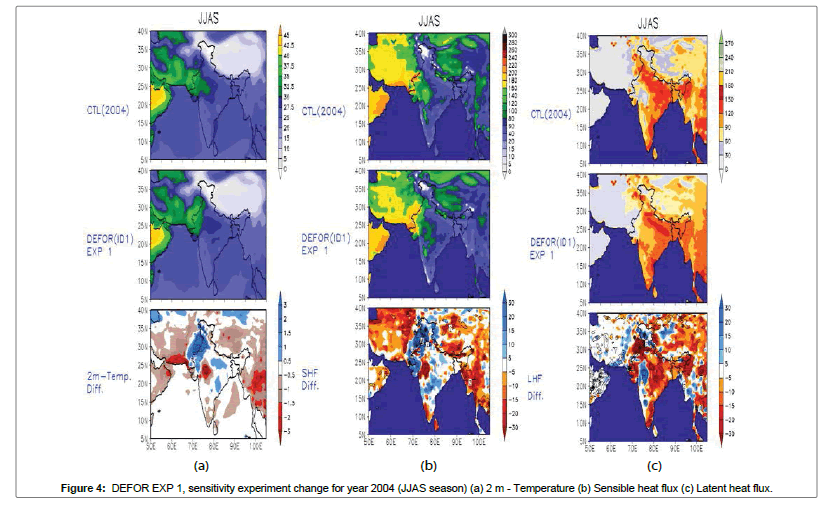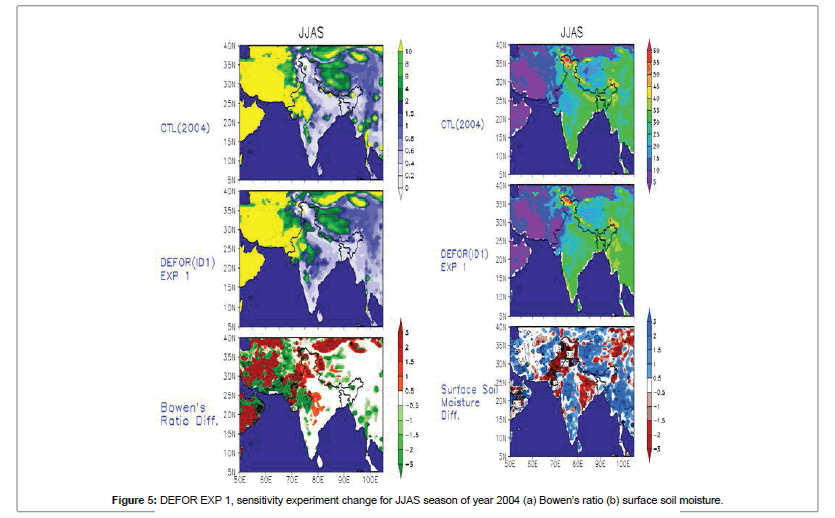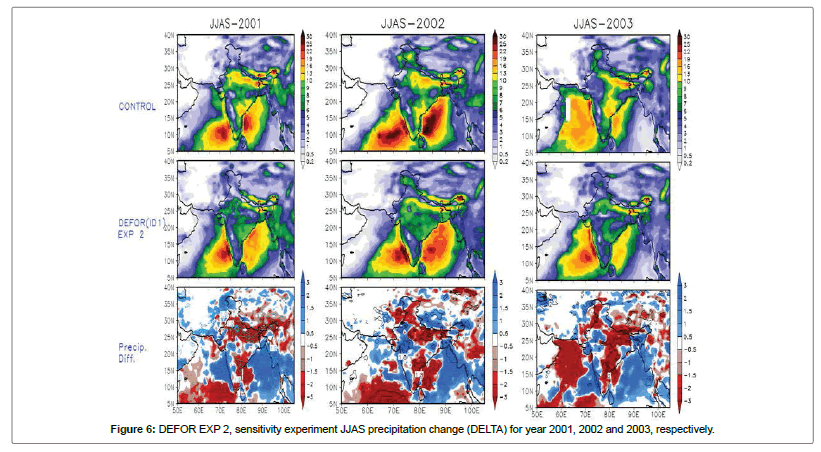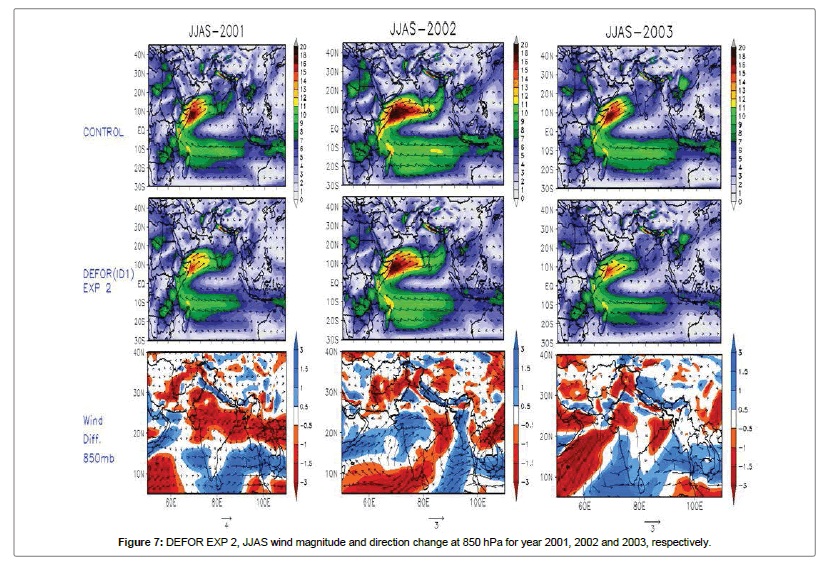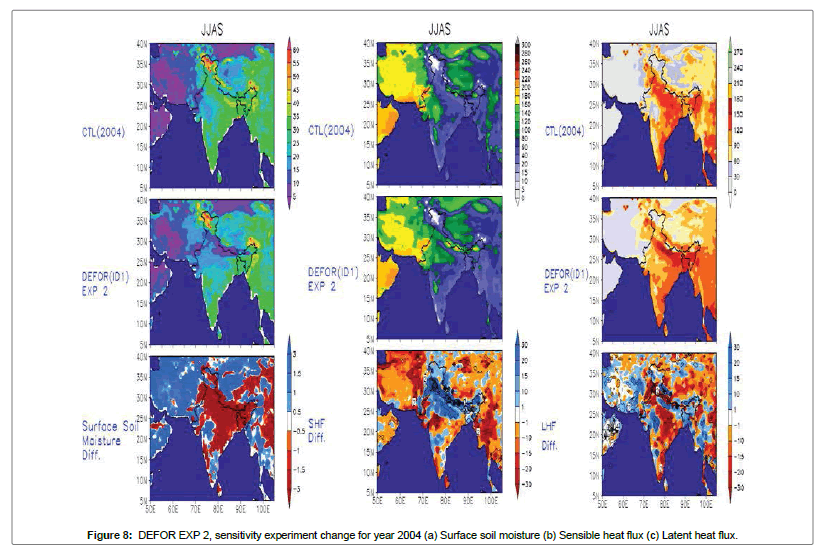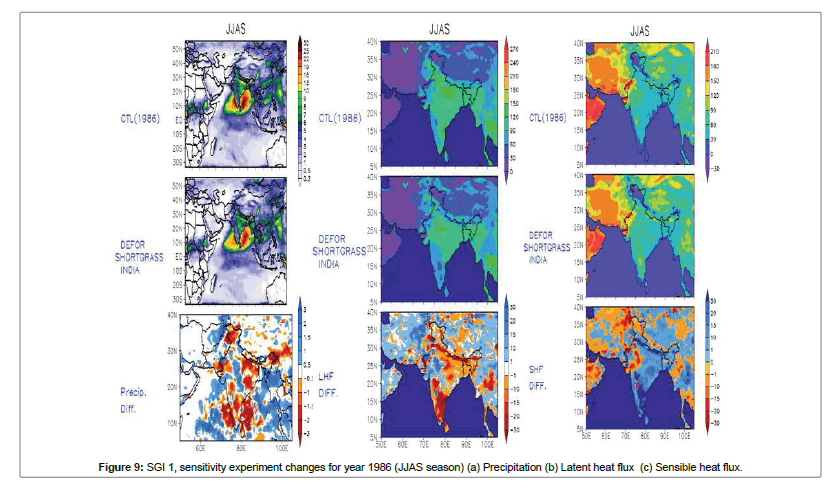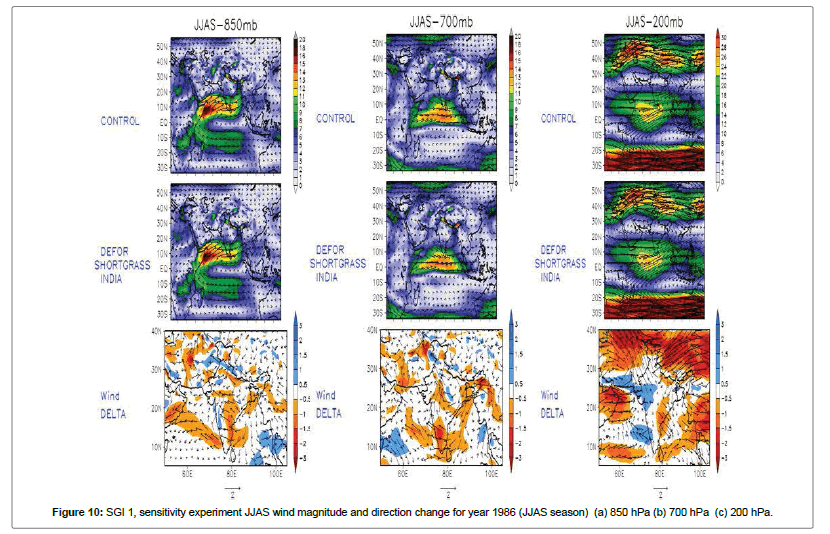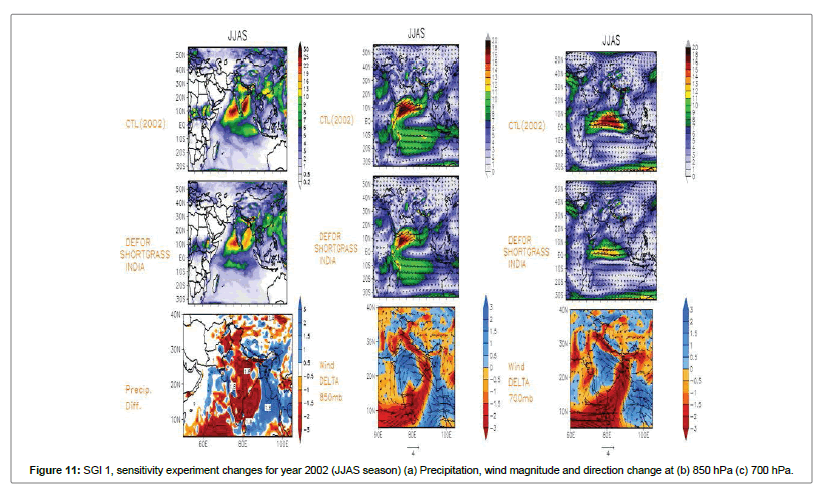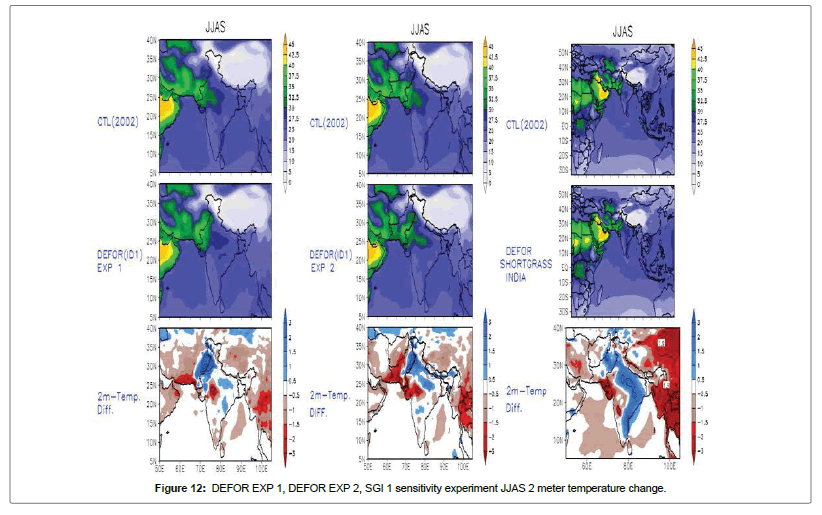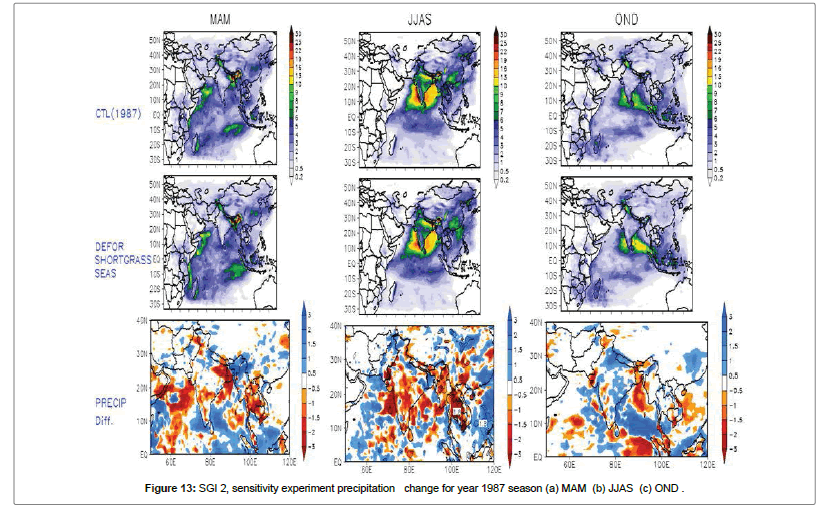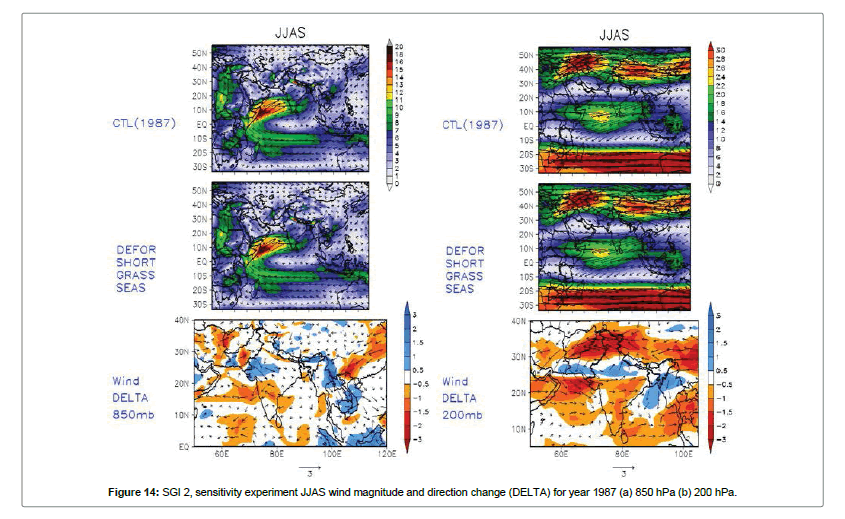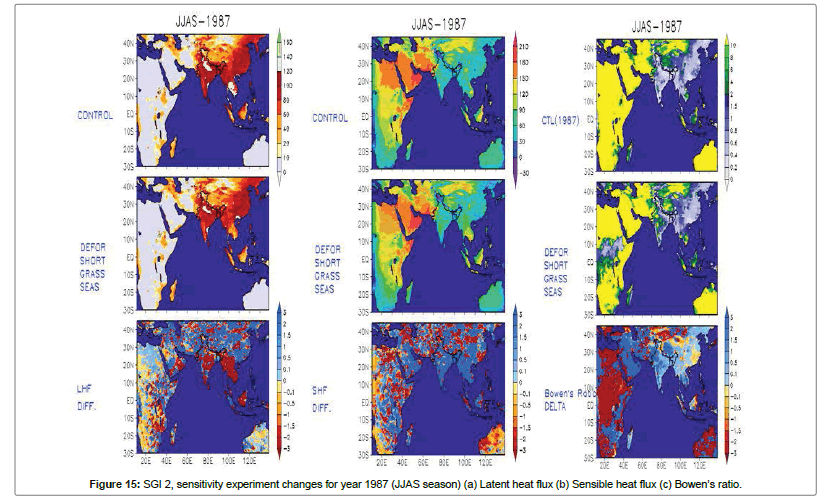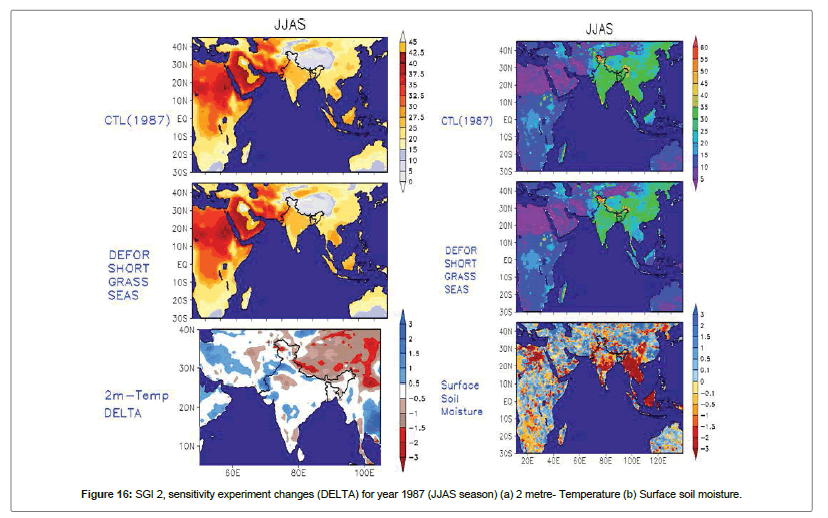Research Article Open Access
Simulated Impact of Desertification and Deforestation on Indian Monsoon Rainfall and Surface Fluxes: RegCM4.0 Simulations
Abhishek Lodh*Indian Institute of Technology Delhi, Centre For Atmospheric Sciences, Hauz Khas, New Delhi 110016, India
- *Corresponding Author:
- Lodh A
Indian Institute of Technology Delhi
Centre for Atmospheric Sciences
Hauz Khas, New Delhi 110016, India
Tel: +91(11) 2659 1301/6029
E-mail: abhishek.lodh@gmail.com
Received Date: September 26, 2016; Accepted Date: February 20, 2017; Published Date: February 24, 2017
Citation: Lodh A (2017) Simulated Impact of Desertification and Deforestation on Indian Monsoon Rainfall and Surface Fluxes: RegCM4.0 Simulations. J Ecosyst Ecography 7: 226. doi: 10.4172/2157-7625.1000226
Copyright: © 2017 Lodh A. This is an open-access article distributed under the terms of the Creative Commons Attribution License, which permits unrestricted use, distribution, and reproduction in any medium, provided the original author and source are credited.
Visit for more related articles at Journal of Ecosystem & Ecography
Abstract
Impact of extensive desertification in northwest India, Himalayan glaciers depletion and tropical deforestation over Indian subcontinent and Southeast Asia, on Indian monsoon circulations, precipitation, surface fluxes is being studied. In this research paper, by changing vegetation types in the bats coupled - regCM4.0, the model impact of desertification and deforestation on Indian monsoons is investigated. By performing these sensitivity experiments (extended desertification, and tropical deforestation) it is found that over India, monsoon precipitation is significantly decreased at local and large scales. Decreased surface roughness length and increase in albedo because of desertification/deforestation in the model results in origination of anomalous westerly winds and subsidence, decreasing turbulent flow, decreasing rainfall over land and strengthening over the seas and consequently increases the temperature over land. Further, the hydrological and atmospheric water cycle gets weak because precipitation decreases. Thus any form of deforestation and desertification happening over tropical regions has a severe impact on Indian summer monsoon atmospheric circulations and precipitation.
Keywords
Desertification; Deforestation; RegCM4.0; Precipitation; Evapotranspiration
List of Abbreviations
BATS: Biosphere Atmosphere Transfer Scheme; BOB: Bay of Bengal; CI: Central India; EF: Evaporative fraction; FAO: Food and Agriculture Organization of the United Nations; GLCC: Global Land Cover Characterization; GMT: Greenwich mean time; ICTP: International Centre for Theoretical Physics; ISM: Indian summer Monsoon; IGP: Indo-Gangetic plain; JJAS: June-July-August- September; ULCC: Land use/land cover change; LHF: Latent heat flux; NWP: North-western part of India; NEI: North-east India; NI: North India; PI: Peninsular India; RegCM4.0; ICTP version 4.0 of Regional Climate model; SHF: Sensible heat flux
Introduction
Global climatic change is resulting from land use changes, particularly tropical deforestation, is indicated by many climate model simulations. Devaraju et al. [1] investigated the impacts of deforestation and found significant reduction of precipitation in each local area in the Northern Hemisphere monsoon regions of East Asia, North America, and North Africa. Displacement of the Inter-Tropical convergence zone more southwards due to high-latitude deforestation indicated in study by Devaraju et al. [1]. Also they suggest that remote effects on rainfall are stronger than local effects. Moreover, they suggested that the effects of deforestation in the tropics spread beyond the deforested area and reach into the mid-latitudes. According to FAO MAR-SFM Working Paper 5 [2] report, deforestation is the conversion of forested areas to non-forest land use such as arable land, urban use, logged area or wasteland or any other another land use or the long-term reduction of tree canopy cover below the 10% threshold1. Deforestation has critically affected Meghalaya that was one of the thickly forested northeastern states of India (NEI). These rates of net forested area change in Southeast Asia particularly India where there is high density of tropical forests. This is because most of the natural resources that we want to extract for rapid GDP growth like coal and iron-ore happen to be in rich forest areas of Indian subcontinent. Inevitably extraction of these minerals will lead to deforestation and decreasing capacity of the valuable carbon sink. Land surface, which is in, direct contact with atmosphere acts as a source and sink for atmospheric moisture. It also regulated feedback to the climate system. Studies such as Boucher et al. [3] concluded that the addition of water vapour in dry regions results in a nonlinear increase in perceptible water at the regional scale, which is compensated by a decrease in water in other regions through changes in convection. Any perturbation in the radiative budget over the subcontinent can weaken the driving pressure gradient and potentially destabilize the summer monsoon circulation [4]. Pioneering work by Charney [5] on albedo effects due to deforestation on climate forms the primary basis of re-investigation in the desertification and deforestation sensitivity experiments using ICTP- RegCM4.0 model. An increase in the albedo over deserts and semi-arid region makes the radiative balance more negative, because it leads to an increase in outgoing radiation. Charney [5] albedo-feedback hypothesis is a partial hypothesis explaining recurring droughts in Sahel region. Sen et al. [6] studies on impact of Indochina deforestation on the Chinese Monsoon and concludes weakening of monsoon flow over East China has far reaching effects. Similarly land surface changes could have a profound impact on the Indian monsoon system. By 2030s Himalayan region over 56% forests are going to be adversely affected, whereas coastal and Western Ghats are moderately affected (30% and 18%, respectively) to climate change. North-eastern states of India are going to be minimally affected (8%) [7].
This paper is a follow-up paper to Lodh [8], Lodh [9,10]. Lodh [11] a re-investigates Himalayan snow – Indian monsoon relationship and impact of land surface degradation over Himalayas, whereas Lodh [9,10], studies impact of impact of afforestation and irrigation intensification on Indian monsoon precipitation and circulations, respectively. In this present research work attempts are made to study increase in desertification and deforestation in the RegCM4.0 model by proxy land use and land cover change induced sensitivity experiments, and to arrive at conclusions in addition to previous studies. Thus, identification of possible changes on regional precipitation and circulation patterns in the Indian monsoon regime through the sensitivity experiments is planned, using a regional climate model. Also, the mechanisms of interaction between land surface and vegetation (via desertification and deforestation) are to be understood. In this paper, the methodology, brief about the sensitivity experiments and their period of study is described in Section 2. “Result and Discussions” of the sensitivity experiment about effect of extensive desertification and deforestation is described in Section 3, and the “Summary and Conclusions” are described in Section 4.
Methodology
The model used in the present study is again ICTP regional climate model (RCM) RegCM4.0 [12-15] installed over the Cordex South Asia domain (12°E to 138°E and 33°S to 55°N) at 90 km horizontal resolution [8,11]. The details of the parameterization schemes and domain of the regional climate model are described in the Lodh [10].
Brief about the desertification and deforestation sensitivity experiments and their period of study
The desertification and deforestation sensitivity experiments are performed to study the critical impact of anthropogenic human activities by conducting landuse and land cover changes in the model, on Indian summer monsoon precipitation and circulation pattern (Figure 1). They are: (a) In the first (DEFOR EXP 1) sensitivity experiment the model landuse pattern over Thar Desert (i.e.,., northwestern part of Indian sub-continent between Pakistan and northwestern India) was changed from crop/mixed farming and semi-desert type of vegetation to desert type of vegetation, thus implementing extensive desertification of Thar Desert. This importance of DEFOR EXP 1 sensitivity experiment is to study the impact of expanding Thar Desert on Indian summer monsoon precipitation, surface fluxes and soil moisture with a potential to redistribute precious water over South Asia. Also previous studies have shown that deforestation in South - East Asia is most severe compared to tropical areas worldwide [16].
Figure 1: Modified land use map for (a) DEFOR EXP 1, extensive desertification over Thar desert (b) DEFOR EXP 2, extensive desertification over Thar desert, Himalayas and Gangetic plains (c) SGI 1, deforestation experiment where deciduous and evergreen broadleaf tree over eastern province (EP), irrigated crop and mixed farming over Gangetic Plains, Orissa is replaced by short grass over India only. (d) SGI 2, deforestation experiment where in addition to deforestation over India, deforestation is also done replacing vegetation classes along the principal axis of monsoon i.e. over the tropical rain-belt regions over Myanmar, Indonesia, Sumatra, Thailand and Cambodia (Indo-Chinese peninsula and Maritime subcontinent) by short grass.
(b) In the second (DEFOR EXP 2) sensitivity experiment (deforestation), in addition to north-western part of Indian subcontinent the model landuse pattern over Gujarat, northern parts of Central India (CI), Indo-Gangetic plains (IGP) and North-eastern India (NEI) was shifted from crop/mixed farming and irrigated crop to desert type of vegetation. Using this sensitivity experiment we are also trying to investigate the effects of Himalayan glaciers depletion on precipitation, surface fluxes and soil moisture in the Indian summer monsoon regime.
The first and second (item no. a and b) experiments are run from 00GMT of 1st November 1999 to 24 GMT 31st Decembers 2005. The model run for the above mentioned time period is done when aerosol chemistry module is on and there is no coupling (i.e., chemistry=true and idirect=1, in the name list file), i.e., aerosol are only transported and don’t interact with radiation scheme, but clear sky and top of atmosphere radiative forcing are diagnosed.
(c) In the third sensitivity experiment (SGI 1), the deciduous and evergreen broadleaf tree over eastern province (EP), irrigated crop and mixed farming over Western Ghats, IGP, eastern India (West Bengal, Bihar, Uttar Pradesh, Orissa and Andhra Pradesh), peninsular India (Tamil Nadu, Kerala), and northern regions of India is replaced by short grass over India only. This sensitivity experiment is run from 1st November 1982 to 24 GMT of 31st December 2002.
(d) In the fourth (SGI 2) sensitivity experiment the “forests” type of vegetation over north-eastern India, Eastern and Western Ghats are replaced by short grass. In addition to deforestation in India, it is also done over the principal axis of monsoon i.e., the tropical rainbelt over Myanmar, Indonesia, Sumatra, Thailand and Cambodia (i.e., over Indo-China peninsula and maritime subcontinent) by replacing vegetation to short grass. Jang et al. [17] has reported in his study that over Indonesia, Myanmar and maritime subcontinent, net primary productivity has significantly decreased. The experiment is run from 1st November 1982 to 24 GMT of 31st Decembers 1990 and from 1st November 1996 to 24 GMT of 31st December 1997 (Sensitivity experiment is done for two time periods for robustness of results). The third and fourth sensitivity experiment are planned to study the role of vegetation, particularly the impact of tropical deforestation along the principal axis of monsoon on precipitation, surface fluxes and soil moisture over Indian sub-continent. To increase the climate change signal from deforestation experiments, the numerical simulations performed in this study removed all trees to short grass wherever deforestation took place along the path of principal axis of monsoon.
The third and fourth sensitivity experiments are done only with aerosol chemistry module is activated, but aerosol are only transported and don’t interact with radiation scheme. Hence, there is no coupling (i.e., chem=1 and idirect =1, in the namelist file). The complete list of experiments can be located at Table 1a.
| Roughness length | Vegetation albedo for Wavelengths <0.7 μm |
Vegetation albedo for Wavelengths >0.7 μm |
Maximum fractional vegetation cover | |
|---|---|---|---|---|
| Crop and mixed farming | 0.08 | 0.1 | 0.3 | 0.85 |
| Semi-desert | 0.1 | 0.17 | 0.34 | 0.35 |
| Desert | 0.05 | 0.2 | 0.4 | 0.0 |
| Short grass | 0.05 | 0.1 | 0.3 | 0.8 |
Table 1a: BATS vegetation land cover table (Source: ICTP RegCM Version 4.0 Core Description Manual).
Results and Discussion
Effect of extensive desertification on precipitation, circulation and surface fluxes
The DEFOR EXP 1 and DEFOR EXP 2 sensitivity experiments are performed using regional climate model, RegCM4.0 where chemistry module is activated but coupling between dynamic and thermodynamic fields is not allowed. The results from the desertification experiment are described as follows:
1) The DEFOR EXP 1 type sensitivity experiment is a modelling study to examine the impacts of expanding Thar Desert on Indian monsoon precipitation (JJAS). Through DEFOR EXP 1 type sensitivity experiment it is found that extended desertification of present Thar Desert significantly affects the seasonal (JJAS, MAM) monsoon at local and large scales. It is observed from Figure 2 that precipitation is decreasing over main lands of Indian (land) region i.e., peninsular India (PI), CI, NI and NWP, except some parts of west coast of India during the JJAS season of year 2001, 2002, 2003, and 2004 (Figures 2 and 3).
From Figure 3 it is observed that in the first year of model run i.e., 2000, there is development of anomalous cyclonic circulation and increase in wind magnitude over east coast of India, but precipitation over Indian (land) region has decreased except east coast and BOB. The expansion of Thar Desert significantly decreases (increases) precipitation over inlands of China (Myanmar coast and BOB) during JJAS season as well (Figure 2). Simultaneously observation of circulation feature shows that wind magnitude over Indian land region, cross equatorial flow has decreased and there is a formation of anomalous anticyclone over eastern India existing at 850 hPa (Figure 3) and extending up to 700 hPa (Figure not shown) for JJAS season 2004. This result is consistent with Bollasina et al. [16]. At 200 hPa there is decrease in magnitude of wind and formation of anomalous big cyclonic circulation over Indian domain. This formation of anomalous anti-cyclonic flow at lower levels (~ 850 hPa) and disturbed land – sea temperature contrast opposes the south-easterly moisture advection from the Bay of Bengal toward the Indo-Gangetic Plain. Also it is observed that decrease in precipitation is more during monsoon (JJAS) season in comparison to pre-monsoon (MAM) and post-monsoon (OND) season. Due to DEFOR EXP 1, extensive Thar Desert experiment shows surface soil moisture has decreased and 2 meter - temperature increase over NWP of Indian subcontinent. Over Indian (land) region there is increase in sensible heat flux, decrease in latent heat flux and increase in Bowen’s ratio (Figures 4 and 5). Extensive desertification over Thar Desert shows that monsoon circulations weaken and precipitation over Indian decreases, thus will affect hydrological cycle over India.
2) The DEFOR EXP 2-sensitivity experiment is performed to see the effects of glaciers depletion on Indian summer monsoon meteorology. Lodh [8] studies Himalayan snow – Indian monsoon relationship and impact of land surface degradation over Himalayas, but in DEFOR EXP 2-sensitivity experiment along with north-western regions of India, intensification of desertification is extended to Himalayas, IGP and NEI. Thus, the influence of landuse changes especially deglaciation on the climatic features particularly on precipitation of the India and neighbouring regions is studied here. In the DEFOR EXP 2 type sensitivity experiment, precipitation tends to significantly decrease (increase) over CI, IGP and PI (BOB, Myanmar coast, Thailand) for year 2001, 2002 and 2003 (Figures 6 and 7).
Also it is observed that JJAS wind magnitude and direction change at 850 hPa tends to decrease over Indian monsoon domain for year 2001, 2002 and 2003 (Figure 7). It is also observed that there is decrease in magnitude of Somali jet. The anomalous anti-cyclonic circulation over Indian subcontinent exists at 850 hPa, extending upto 700 hPa. Similar to DEFOR EXP 1, at 200hPa there is decrease in magnitude of wind and formation of anomalous big cyclonic circulation over India (Figure 8).
From Figure 8, it is observed that surface soil moisture has decreased over CI, IGP, NWP, NEI region of India and Nepal where desertification in model is implemented. Correspondingly, sensible heat flux has increased and latent heat flux has decreased over Indian (land) region, especially over NWP, IGP and NEI. Surface pressure has increased over Indian (land) region particularly between 20N and 25N (i.e., north-western region of Indian subcontinent by 1.8 to 3.2 hPa) in both DEFOR EXP 1 and 2 sensitivity experiments (Figure not shown). Runoff decreases in IGP, both in DEFOR EXP 1 and 2 (Figure not shown) and hence, water cycle weakens as precipitation decreases [16]. The precipitation differences between the standard and sensitivity experiment DEFOR EXP 1, DEFOR EXP 2 is also calculated and found to be significant at 5% and 1% level of confidence, respectively (Figure not shown).
Hence, from regional climate model simulations it is seen that circulation pattern is changing due to Himalayan glacier melting and possible deforestation activities over Himalayas. Though the amount of precipitation over Indian (land) is decreasing, a climate simulation of longer duration will tell whether precipitation decrease will lead to a hysteresis loop eventually affecting Indian monsoon meteorology in future. Hence, glaciers/snow cover’s existence over Himalayas is very important for sustaining monsoon precipitation over windward region of Himalayas, as major river systems of Indian-subcontinent originate here.
Effect of deforestation on precipitation, circulation and surface fluxes
Model simulations with SGI 1 and SGI 2 sensitivity experiments are designed to test the role of vegetation along the principal axis of monsoon. The principal axis of monsoon is explained in the paper Krishnamurti et al. [18]. The results from the deforestation experiment are described as follows:
1) In the SGI-1 sensitivity experiment, performed using short grass as vegetation over India (i.e., deforestation over India only), during the JJAS season precipitation has decreased over Indian land region (Figures 9-11).
But precipitation has increased over Myanmar’s Arakan Mountains, Indo-China peninsula. It is observed that precipitation has decreased over Indian (land) region during post-monsoon season too. It is observed from wind plots for year 1986 that there is decrease in magnitude of wind and formation of anomalous anticyclone over India (Peninsular India, PI) extending upto 700 hPa (Figures 10 and 11).
Thus, formation of anticyclone over PI along with decrease in wind magnitude during JJAS season provides hindrance to monsoon flow and hence results in decrease in monsoon precipitation over India. Simultaneously there is decrease in surface soil moisture, latent heat flux over India and increase in sensible heat flux, Bowen’s ratio and 2 - metre temperature over India mimicking the areas where vegetation change is done (Figures 9 and 12). Analysis done for JJAS season of year 2002 once again shows JJAS season precipitation has decreased over Indian (land) region and with formation of anomalous anticyclone over India at 850 hPa extending upto 700 hPa and decrease in wind magnitude over oceanic region. There is also increase in temperature at 2-metre over India due to DEFOR EXP1, DEFOR EXP2 and SGI 1 experiment (Figure 12).
The decrease in precipitation in SG1 sensitivity experiment is significant at 5% level of confidence (Figure not shown).
2) SGI-2 sensitivity experiment is done to test the role of vegetation in the progress of monsoon along its principal axis. Along the principal axis of monsoon “forests” type of vegetation over north-eastern India, eastern region of India, Western Ghats of India, tropical rainbelt over Myanmar, Indonesia, Indo-China peninsula and maritime subcontinent are replaced by short grass. A JJAS precipitation change for year 1982, 1983 shows that precipitation over Indian (land) region and maritime subcontinent precipitation is decreasing (Figure not shown). The corresponding anomalous wind pattern at 850 hPa shows that over the Indian (land) region atmospheric circulations is decreasing. For the year 1982 monsoon (JJAS) wind anomaly has increased over the ocean but over Indian (land) region circulations has decreased and simultaneously precipitation has also decreased (Figures 13 and 14).
It is observed from Figure 13 that monsoon (JJAS) precipitation has decreased over Indian and South-east Asian land region as well. The wind magnitude at 850 hPa has decreased and direction reversed during monsoon (JJAS) 1987. Latent heat flux and surface soil moisture has decreased, and sensible heat flux has increased over whole of the tropical rain-belt from India to Thailand and Cambodia region of south – East Asia (Figures 15 and 16).
Hence, due to tropical deforestation precipitation and soil wetness has decreased over India and South – East Asia along the principal axis of monsoon during the monsoon season. Over BOB there exists an anomalous cyclonic circulation at 850 hPa. Surface pressure has over Indian (land) region decreases (by -0.3 to -1.2 hPa) in both SGI 1 and SGI 2 sensitivity experiments (Figure not shown). The decrease in precipitation in SG2 sensitivity experiment is significant at 5% level of confidence (Figure not shown).
Summary and Conclusions
The conclusions drawn are based on desertification and deforestation sensitivity experiments performed using regional climate model, RegCM4.0. Intensive exploitation of natural resources (water in particular) has been taking place over the relatively dry north-western India, as a result of rapid population growth and expansion. As a result, the Indian subcontinent and South-Asian region is under the threat of desertification [2]. This argument provided the motivation for the deforestation related sensitivity experiments. Our findings suggest that the expansion of the Thar Desert at the expense of cultivated and irrigated land (Indus basin) significantly impacts the summer monsoon precipitation over the entire Indian subcontinent, both locally and at regional scale. Deforestation experiment results reported by Bollasina et al. [16], Gupta et al. [19] also reports it. Because of interactions with the surrounding topography and land surface feedbacks within the developing monsoon, the effect of an expanded desert leads to decrease in monsoon precipitation over Indian subcontinent.
Anomalous anti-cyclonic circulation over east part of India is formed in DEFOR EXP 1, DEFOR EXP 2 and SGI 1 experiment and over west India in the SGI 2 experiment. Moreover from SGI 1 experiment deforestation over India leads to increase in precipitation over the eastern Himalayas (NEI), Arakan mountain region in Myanmar and Indochina peninsula, strengthening previous studies, Bollasina et al. [16], even though region of deforestation is different. But deforestation over Indo-China peninsula and maritime subcontinent (SGI 2 deforestation experiment) shows that precipitation over Indo-China peninsula, maritime subcontinent, Central India, west India decreasing significantly, whereas over ocean i.e., BOB and South China Sea, it has increased. The anti-cyclonic circulation developing over BOB decreases moisture advection, detracting all moisture from nearby regions. But over land, the magnitude and direction of wind reversed due to reduced surface roughness and increase in albedo. This feature is well known and reported in Sen et al. [6]. Werth et al. [20-22] died the consequences of Southeast-Asian deforestation, and the present study also reports local effects, and decrease in Asian precipitation persisting all seasons of the year. The study by Sen et al. [6] also explains the possible mechanism of Indo-China deforestation and its teleconnection effects. The DEFOR EXP 1 and DEFOR EXP 2 sensitivity experiments when repeated with aerosol module in idirect=2 mode (allowing aerosol radiative feedbacks in the model simulations), similar conclusions are obtained (Figures not shown). As earlier mentioned in the SG 2 experiment, decreasing surface pressure combined with decreasing wind magnitude results in calm but dry north-westerly over Indian (land) region and Indo-China peninsula, not allowing southerly winds to march ahead towards land. These changes in monsoonal flow affect moisture-laden winds from BOB to move towards land. Hence, any perturbation in the vegetation cover, radiative budget over the Indian sub-continent and outside can weaken the driving north-south pressure gradient and the summer monsoon circulation is destabilized [5].
This study is a preliminary study that uses regional climate model (RegCM4.0) and conclusions drawn from proxy sensitivity experiments are not definitive and open for further introspection. Simulations of longer time scale with sensitivity and control experiments performed with different combination of cumulus and planetary boundary layer schemes will yield more robust results. It is broadly recognized that the landscape and land cover changes significantly impact the overlying atmosphere, surface fluxes and hence land surface processes. The degree of the impact due to land-use/ land cover change is a complex process and further studies like Dirmeyer et al. [23], Ferranti et al. [24] needs to be undertaken. Also a limitation of present experiments in this study is coarse (90 km) resolution of the model run. Even though the model is able to properly simulate the prominent features of ISM, more simulations with ensemble and multiyear runs (at higher resolution) are necessary to obtain robust results and ascertaining the results produced at 90 km resolution.
To make realistic changes, experiments with high-resolution regional climate models with real-time LULCC, in-situ and gridded soil moisture datasets are required [25,26] over Indian region. Nevertheless, the findings of this study using a regional climate model puts forward a fresh attempt to assess the impact of desertification and tropical deforestation on Indian monsoon meteorology. The sensitivity experiments (desertification and deforestation) tell those land-atmosphere interactions predominant over CI and north-western part of Indian subcontinent, as soil moisture changes are limited to that region. Moreover soil moisture temperature coupling [27] along with land degradation over northwest India could result in occurrence in more droughts over the scanty rainfall regions of Indian subcontinent. The deforestation sensitivity experiment results confirm that higher vegetation albedo (lower surface roughness; (Table 1b) reduces the absorbed solar radiation at the surface [28], leading to cooler land temperature (particularly over NWP region) and hence decreased land-sea heat contrast. Hence, the easterlies from BOB do not move towards land, hence precipitation over land decreases. Whereas, the deforestation experiment (with short grass, SGI 1) shows increase in land temperature over the areas where sensitivity is done. Therefore, vegetation albedo has a negative effect on the ISM development, generally statistically significant. The importance of north-western region of India (particularly where low pressure is formed during JJAS season) is reflected from the experiments. Further ISM circulations over are a part of periodic global atmospheric circulations and landuse/landcover change induced precipitation, changes in surface fluxes are found to be significant. Clearly the deforestation and any form of land degradation clearly effects land surface temperature, diurnal temperature variation of ground and relative distribution of fluxes of heat and moisture [29-31]. Ecosystem research on impacts of irrigational intensification as explained in Lodh A. [10] and deforestation/desertification needs further interdisciplinary investigation.
| Experiment name and its acronym | Domain and Resolution | Land-surface condition and duration of simulation run | Details of Parameterization schemes used |
|---|---|---|---|
| 1. RegCM4.0-DEFOR EXP 1 (chemistry=true, idirect=1) |
11°E-139°E, 34°S- 55°N (Cordex South Asia), ~ 90km (160´130´18, Normal Mercator map projection). The central point is located at 75°E and 15°N (approx.) | •ExpandedThar Desert experiment •00GMT 1st November 1999 to 24 GMT 31st December 2005 |
(a) Grell scheme with Fritsch and Chappell closure and Holstag PBL scheme. (b) Original ASCII text landuse map in the RegCM4 model altered to incorporate the design experiments. |
| 2.RegCM4.0-DEFOR EXP 2 (chemistry=true, idirect=1) |
-do- | •Effects of Himalayan Glaciers depletion •00GMT 1st November 1999 to 24 GMT 31st December 2005 |
|
| 3. RegCM4.0 -SGI 1(chemistry=true and idirect=1) | -do- | •Effect of deforestation over India •1st November 1982 to 24 GMT of 31st December 2002 |
|
| 4. RegCM4.0 -SGI 2 (chemistry=true and idirect=1) | -do- | •Deforestation over India and regions covered by the principal axis of monsoon (i.e. over Indo-China peninsula and maritime subcontinent) •1st November 1982 to 24 GMT of 31st Decembers 1990 and •1st November 1996 to 24 GMT of 31st December 1997 |
Table 1b: List of desert sensitivity experiments using Regional Climate model.
Acknowledgment
Firstly the author acknowledges the central cloud - computing facility (Baadal) available at Computer Services Centre and AJAYMERU & CHANDRA at Centre for Atmospheric Sciences, IIT Delhi for the regional climate model simulations, Abdus Salam International Centre for Theoretical Physics, Trieste, Italy for RegCM4.0 model codes and National Center for Environmental Prediction/ National Center for Atmospheric Research (NCEP/NCAR) for providing high-resolution meteorological datasets. The Grid Analysis and Display System (GrADS) version 2.0 software is used for plotting and the centre for climate research, University of Wisconsin- Madison sample grads script. The author thanks Dr. H.C. Upadhyaya for his encouragement and suggestions. The author takes this opportunity to acknowledge the pioneering research work done by researchers around the world in studying impact of deforestation on monsoon. The websites www.ccr.aos.wisc.edu and http://www.jamstec.go.jp/frsgc/research/iprc/nona/grads.html is acknowledged for sample GrADS sample scripts. Wealth of online resource available at www.google. com, scholar.google.com was also helpful. Also acknowledged is Institute student fellowship provided by MHRD (Govt. of India).
1(Source: http://www.fao.org/forestry/18222-045c26b711a976bb9d0d17386ee8f0e37.pdf )
References
- Devaraju N, Govindasamy B, Modak A (2015) Effects of large-scale deforestation on precipitation in the monsoon regions: Remote versus local effects. PNAS 112: 3257-3262.
- FAO (2007) Manual on Deforestation, degradation and fragmentation using Remote sensing and GIS. Strengthening, monitoring, assessment and reporting on Sustainable Forest management in Asia (GCP/INT/988/JPN). MAR-SFM Working Paper 5 - 2007 report, prepared by GiriTejaswi Rome.
- Boucher O, Myhre G, Myhre A (2004) Direct human influence of irrigation on atmospheric water vapor and climate. Climate Dynam 22: 597 - 604.
- ZickfeldK, KnopfB, PetoukhovV, SchellnhuberHJ (2005) Is the Indian summer monsoon stable against global change? Geophysical ResLetters32.
- Charney J (1975) Dynamics of desert and drought in the Sahel. Q J Roy Meteor Soc 101: 193-202.
- Omer LS, Wang Y, Wang B (2003)Impact of Indochina Deforestation on the East Asian Summer Monsoon. J Climate 17: 1366-1380.
- INCCA (2010) Report: Climate Change and India: A 4X4 ASSESSMENT: A sectoral and regional analysis for 2030’s. Ministry of Environment and Forests, Govt of India.
- Lodh A (2015) Studying Himalayan snow - Indian monsoon relationship by some LULCC change sensitivity experiments in RegCM4.0. International Journal of Geology and Earth Sciences.
- Lodh A (2016) Modeling the impact of afforestation on monsoon meteorology over indian subcontinent: rethinking an old paradigm. J Earth SciClim Change 7: 333.
- Lodh A (2016) Simulated impact of intensification of irrigation on Indian monsoon rainfall and surface fluxes. Hydrol Current Res 7: 233.
- Lodh A (2015) Impact of caspian sea drying on indian monsoon precipitation and temperature as simulated by RegCM4 model. Hydrol Current Res 6: 217.
- Giorgi F, Coppola1 E, Solmon1 F, Mariotti1 L, Sylla MB, et al. (2011)RegCM4: model description and preliminary tests over multiple CORDEX domains. Climate Res 52: 7-29.
- Das S, Dey S, Dash SK, Basil G (2013) Examining mineral dust transport over the Indian subcontinent using the regional climate model, RegCM4.1. Atmos Res 134: 64-76.
- Dash SK, Shekhar MS, Singh GP (2006) Simulation of Indian summer monsoon circulation and rainfall using RegCM3. TheorApplClimatol 86: 161-172.
- Dash SK, Sharma N, Pattnayak KC, Gao XJ, Shi Y (2012) Temperature and precipitation changes in the northeast India and their future projections. Glob Planet Chang 98-99: 31-44.
- Bollasina M, Nigam S (2011) Modeling of Regional Hydroclimate Change over the Indian Subcontinent: Impact of the Expanding Thar Desert. J Climate.
- Jang CL, Nishgami Y, Yanagisawa Y (1996) Assessment of global forest change between 1986 and 1993 using satellite-derived terrestrial net primary productivity. Environ Conserv 23: 315-321.
- Krishnamurti TN, Bhalme HN (1976) Oscillations of a monsoon system. Part I. Observational aspects. J AtmosSci 33: 1937-1954.
- Gupta A, Thapliyal PK, Pal PK, Joshi PC (2005) Impact of Deforestation on Indian Monsoon: A GCM Sensitivity Study, J IndGeophys Union 9: 97-104.
- WerthD,Avissar R (2002) The local and global effects of Amazon deforestation.J Geophys Res 107: LBA 55-1–LBA 55-8.
- WerthD, AvissarR (2005)The local and global effects of African deforestation. Geophys Res Lett32: L12704.
- WerthD,Avissar R (2005b) The local and global effects of Southeast Asian deforestation. Geophys Res Lett32: L20702.
- Dirmeyer PA, Jin Y, Singh B, Xiaoqin Y (2013) Trends in Land-Atmosphere Interactions from CMIP5 Simulations. J Hydrol.
- Ferranti L, Slingo JM, Palmer TN, Hoskins BJ (1999) The effect of land-surface feedbacks on the monsoon circulation, Q J R MeteorolSoc 125:1527-1550.
- Roy PS, Behera MD, Murthy MSR, Roy A, Singh S, et al. (2015) New vegetation type map of India prepared using satellite remote sensing: comparison with global vegetation maps and utilities. International Journal of Applied Earth Observation and Geoinformation 39: 142-159.
- Unnikrishnan CK, George JP, Lodh A, Maurya D, Mallick S, et al. (2016)Comparison of two high resolution gridded soil moisture products over India, Journal of Earth System Science and Climate Change (India Academy of Sciences) 5: 935-944.
- Ramarao MVS, Sanjay J, Krishnan R (2016) Modulation of summer monsoon sub-seasonal surface air temperature over India by soil moisture- temperature coupling, Mausam. Q JMeteorolHydrolGeophys 67: 53-66.
- Charney J (1977) A comparative study of the effect of albedo change on drought in semi-arid regions. J AtmosSci 36: 1366-1385.
- SudYC, SmithWE (1985) Influence of local land-surfaceprocesses on the Indian monsoon: A numerical study. J ClimApplMeteorol24: 1015-1036.
- BathianyS, Claussen M,Brovkin V,Raddatz T, Gayler V (2010) Combined biogeophysical and biogeochemical effects of large-scale forest cover changes in the MPI earth system model. Bio geosciences7: 1383-1399.
- Lodh (2015)Studying Indian Monsoon, Land Atmosphere Interactions Using Land Use/Land Cover Change Sensitivity Experiments.
Relevant Topics
- Aquatic Ecosystems
- Biodiversity
- Conservation Biology
- Coral Reef Ecology
- Distribution Aggregation
- Ecology and Migration of Animal
- Ecosystem Service
- Ecosystem-Level Measuring
- Endangered Species
- Environmental Tourism
- Forest Biome
- Lake Circulation
- Leaf Morphology
- Marine Conservation
- Marine Ecosystems
- Phytoplankton Abundance
- Population Dyanamics
- Semiarid Ecosystem Soil Properties
- Spatial Distribution
- Species Composition
- Species Rarity
- Sustainability Dynamics
- Sustainable Forest Management
- Tropical Aquaculture
- Tropical Ecosystems
Recommended Journals
Article Tools
Article Usage
- Total views: 5448
- [From(publication date):
May-2017 - Mar 31, 2025] - Breakdown by view type
- HTML page views : 4485
- PDF downloads : 963

